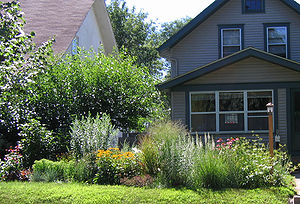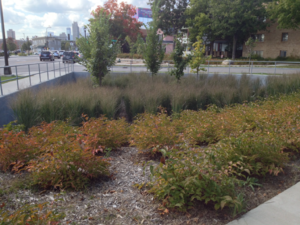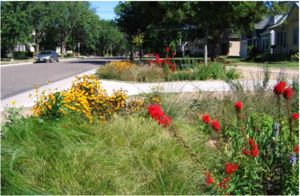
Green Infrastructure benefits of bioretention
This page is in development
Bioretention practices, often called rain gardens, are small vegetated landscape practices designed to filter or infiltrate stormwater runoff. They have a relatively simplistic design that can be incorporated into a wide variety of landscaped areas. Common bioretention opportunities include landscaping islands, cul-de-sacs, parking lot margins, commercial setbacks, open space, rooftop drainage and street-scapes (i.e., between the curb and sidewalk).
Contents
Nomenclature and definitions for green infrastructure benefits
There are a wide variety of green infrastructure (GI) benefits identified in the literature and no universal nomenclature or set of definitions. Nomenclature and definitions used in the following discussion are described in detail at the page called Nomenclature and definitions for green infrastructure benefits.
Green Infrastructure benefits of bioretention
| Benefit | Effectiveness | Notes |
|---|---|---|
| Water quality | Benefits are maximized for bioinfiltration. Biofiltration may export phosphorus if not designed properly. | |
| Water quantity/supply | Bioinfiltration helps mimic natural hydrology. Some rate control benefit. | |
| Energy savings | ||
| Climate resiliency | Provides some rate control. Impacts on carbon sequestration are uncertain. | |
| Air quality | ||
| Habitat improvement | Use of perennial vegetation and certain media mixes promote invertebrate communities. | |
| Community livability | Aesthetically pleasing and can be incorporated into a wide range of land use settings. | |
| Health benefits | ||
| Economic savings | Generally provide cost savings vs. conventional practices over the life of the practice. | |
| Macroscale benefits | Individual bioretention practices are typically microscale, but multiple bioretention practices, when incorporated into a landscape design, provide macroscale benefits such as wildlife corridors. | |
| Level of benefit: ◯ - none; ◔; - small; ◑ - moderate; ◕ - large; ● - very high | ||
Because of their diversity and use of vegetation, bioretention practices provide multiple green infrastructure benefits.
- Water quality: Bioretention is an excellent stormwater treatment practice due to the variety of pollutant removal mechanisms, including vegetative filtering, settling, evaporation, infiltration, transpiration, biological and microbiological uptake, and soil adsorption. Bioretention can be designed as an effective infiltration / recharge practice, particularly when parent soils have high permeability (> ~ 0.5 inches per hour). Bioretention designed for infiltration (bioinfiltration) removes 100 percent of pollutants for the portion of runoff water that is infiltrated, although there may be impacts to shallow groundwater. Bioretention designed as filtration (biofiltration) employs engineered media that is effective at removing solids, most metals, and most organic chemicals. Removal of phosphorus depends on the media (link here). Links to water quality information for bioretention - [1]; [2]
- Water quantity and hydrology: Bioretention can be designed as an effective infiltration / recharge practice when parent soils have high permeability. For lower permeability soils an underdrain is typically used and some infiltration and rate control can be achieved.
- Climate resiliency: It is unclear if bioretention provides benefits for climate resiliency. Carbon may be sequestered, particularly if shrubs and trees exist in the practice. Bioretention also provides some reduction in peak flow. Carbon emissions for construction and maintenance may offset carbon benefits (Moore and Hunt, 2013). Winston (2016) provides a detailed analysis of resiliency of bioretention systems based on different design considerations, such as bowl depth and vegetation utilized in the practice.
- Habitat improvement: Properly designed bioretention practices provide good habitat for invertebrates (Kazemi et al., 2009; Mehring et al., 2016). Beneficial effects are improved considerably when multiple bioretention practices exist over a landscape, as opposed to isolated bioretention practices.
- Community livability: Bioretention is an aesthetically pleasing practice that can easily be incorporated into various landscapes. A variety of vegetation can also be used, including perennial plants, shrubs, and trees.
- Health benefits: Green spaces may also improve mental and physical health for residents and reduce crime (Barton and Rogerson, 2017).
- Economic savings: Properly designed and integrated bioretention practices provide life cycle cost savings. Well designed and maintained bioretention practices increase property values.
Design considerations
Maximizing specific green infrastructure (GI) benefits of bioretention practices requires design considerations prior to constructing the practice. While site limitations cannot always be overcome, the following recommendations maximize the GI benefit of bioretetnion.
- Water quality
- Maximize infiltration by designing with the maximum ponded depth that can be infiltrated in 48 hours, up to 1.5 feet (to protect vegetation). Where space allows, surface area can also be increased. Utilize multiple bioretention practices in series. On lower permeability soils where an underdrain is used, raise the underdrain to the maximum extent possible, allowing water stored in the bioretention media below the underdrain to drain in 48 hours. Use an upturned elbow in underdrained systems.
- For bioinfiltration (bioretention without an underdrain), use a high organic matter media to maximize pollutant removal
- For biofiltration (bioretention with an underdrain), use a media mix that does not export phosphorus or use an amendment to attenuate phosphorus.
- Water quantity/supply
- Maximize infiltration
- Utilize internal water storage
- Maximize water storage in media
- Climate resiliency
- To reduce heat island effects, select vegetation that reflects solar energy, absorbs solar energy and releases it slowly, or that maximizes evapotranspiration NYC Mayor’s Office of Recovery and Resiliency
- Oversize bowl depth (storage) to account for increased precipitation. Winston (2016) recommends oversizing by 33-45% for bioretention in northern Ohio. Oversizing can also be accomplished by reducing loading to individual bioretention practices.
- Establish thicker media depths (Winston (2016) recommends 48 to 102 inches for northern Ohio) to enhance vegetation survival during wet or extended dry periods.
- Utilize internal water storage
- Habitat
- Utilize native, perennial vegetation, including shrubs and trees if space allows. For more information, see Minnesota plant lists.
- Incorporate landscape features, such as form, plant layering, and plant density. For more information on landscape factors, see this presentation by Dr. Steven Rodie (University of Nebraska at Omaha)
- Maximize leaf/plant litter depth and the number of plant taxa
- Consider shape and size to create larger interior habitats
- Evaluate adjacent plant communities for compatibility with proposed bioretention area species. Identify nearby vegetated areas that are dominated by nonnative invasive species.
- Promote soil (media) that maximizes habitat for invertebrate. This includes adjusting pH, limiting the amount of gravel, and promoting development of organic matter. See Kazemi et al. (2009) for more information.
- Community livability
- Choose locations for bioretention that enhance aesthetics
- Choose vegetation that mimics a native landscape, such as tall grass prairie or mixed woodland.
- Evaluate the best placement of vegetation within the bioretention area. Place plants at irregular intervals to replicate a natural setting. Trees should be placed on the perimeter of the area to provide shade and shelter from the wind. Trees and shrubs can be sheltered from damaging flows if they are placed away from the path of the incoming runoff. In cold climates, species that are more tolerant to cold winds, such as evergreens, should be placed in windier areas of the site.
- Health benefits
- Choose locations for bioretention that enhance aesthetics
- Perennial vegetation, particularly shrubs and trees, provide health beenfits related to filtering air pollutants. See The Health Benefits of Trees (Hamblin, 2014)
- Economic benefits
- Choose the correct BMP. There is no comprehensive guidance on this, but an important factor in selecting BMPs is cost per unit treatment. This depends on the goal of the project, but examples of costs may be dollars per cubic foot of water treated or per pound of pollutant. Barr Engineering completed a report that provides information on construction costs, maintenance costs, and land requirements for several stormwater BMPs. The report includes references to other useful reports. Information in the report can be used to match the site goals (e.g. infiltration vs. filtration) and site conditions (e.g. large vs. small site) to the most cost-efficient BMP.
- Factor in all benefits in evaluating the economic value of a BMP or multiple GI practices. For example, appropriate implementation of GI practices can enhance property values. Proper selection of vegetation provides energy savings. Utilizing captured rainwater as an indoor non-potable water source provides savings on energy and water use.
- Utilize multiple properly placed BMPs that work together. For example, permeable pavement can be integrated with tree trenches and tree boxes to provide an aesthetically pleasing landscape that increases the value of the property while increasing the efficiency of stormwater treatment.
Recommended reading
- Rain gardens & other bioretention systems, County Health rankings
- Meeting Hydrologic and Water Quality Goals through Targeted Bioretention Design. Journal of Environmental Engineering/Volume 138 Issue 6 - June 2012. William F. Hunt, M., Allen P. Davis, and Robert G. Traver
- Mitigation of Impervious Surface Hydrology Using Bioretention in North Carolina and Maryland. Journal of Hydrologic Engineering/Volume 14 Issue 4 - April 2009. Houng Li; Lucas J. Sharkey, William F. Hunt; and Allen P. Davis
References
- Adger, W. Neil. 2006. Vulnerability. Global Environmental Change 16:268–281.
- Barton, S. 2009. Human benefits of green spaces. University of Delaware Bulletin #137. 2009.
- Folke C. 2006. Resilience: the emergence of a perspective for social–ecological systems analyses. Global Environ Change. 16:253–267.
- Kazemi, F., S. Beecham, J. Gibbs, and R. Clay. 2009. Factors affecting terrestrial invertebrate diversity in bioretention basins in an Australian urban environment. Landscape and Urban Planning. Vol. 92:3-4:304-313.
- Kazemi, F., S. Beecham, and J. Gibbs. 2009. Streetscale bioretention basins in Melbourne and their effect on local biodiversity. Ecological Engineering. 35:1454-1465.
- Mehring, A.S., B. E. Hatt, D. Kraikittikun, B. D. Orelo, M. A. Rippy, S. B. Grant, J. P. Gonzalez, S. C. Jiang, R. F. Ambrose, and L. A. Levin. 2016. Soil invertebrates in Australian rain gardens and their potential roles in storage and processing of nitrogen. Ecological Engineering. 97:138-143.
- Moore, T., and W.F. Hunt. 2013. Predicting the carbon footprint of urban stormwater infrastructure. Ecological Engineering. Volume 58, September 2013, Pages 44-51.
- New York City Mayor’s Office of Recovery and Resiliency. 2017. Preliminary Climate Resiliency Design Guidelines.


